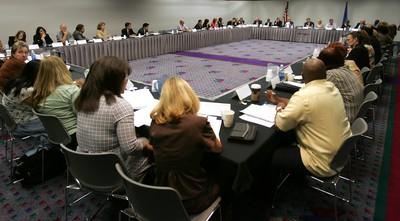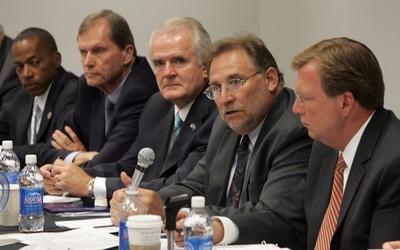Child welfare gets a checkup
What plagues Clark County's child welfare system has been diagnosed by authorities high and low -- inadequate and poorly trained staff, incomplete investigations of reported abuse and neglect, a foster parent shortage and child removal rates that exceed the national average.
The cure recently prescribed by local, state and federal officials is significantly increased funding paired with more stringent oversight and regulation.
On Monday, U.S. Rep. Jon Porter assembled a round table of child welfare advocates and administrators from all levels of community and government to check up on what improvements have been made within the ailing service system and what remains to be done.
"I am very optimistic and encouraged, but I still think we have a lot of work to do," said Porter, who became involved with local child welfare issues after last year's string of high-profile tragedies involving children in protective custody. "And the only way we can do it is as a team."
U.S. Rep. Shelley Berkley, Gov. Jim Gibbons, Assemblywoman Barbara Buckley, Nevada Supreme Court Chief Justice William Maupin and Clark County Commissioners Lawrence Weekly and Bruce Woodbury were among those who attended the discussion organized by Porter.
The assembled political will bodes well for Nevada's reform effort, said Casey Family Programs President William Bell. Having everyone join in the discussion means that everyone is informed about the challenges in front of them.
"I don't know of very many places in the country where this type of conversation takes place, with this type of leadership sitting around the table," said Bell, who represents the nation's largest operating foundation focused on improving foster care.
"I am absolutely convinced that Nevada can become, if not the best, then one of the best child welfare systems in the country," Bell said.
But before that has a chance of happening, those at the table acknowledged that the strides made to date have just been the first steps of reform.
Mike Willden, Nevada director of the Department of Health and Human Services, said that Gibbons and state lawmakers supported an unprecedented increase in child welfare funding to Clark County in the last session. The 2007-09 state allocation for Clark County is $131 million, up from $80 million in state funding for the last two years, Willden said.
But while Clark County now has the funding to beef up staffing and training, it's still reeling from the problem of turnover and the culture of blame that singles out child welfare workers as the problem. Clark County Director of Family Services Tom Morton said turnover in his department is at about 14 percent annually.
That's only to be expected in any system undergoing dramatic changes, Morton said. But those who remain are rising to the occasion and meeting new mandates to close cases within 45 days and improve record keeping. Supervision is also being expanded Morton said, with Family Services working toward having one supervisor for every five case workers.
"A year from now, I think you'll see a very different organization," Morton said.
UNLV Professor of Social Work Leroy Pelton worried that too much attention was being focused on what to do after children are taken into custody. Not enough attention is being placed on how to reduce the number of children who come into the system in the first place. Families could remain intact if the resources used to place children in foster care and at Child Haven were redirected and used for family housing.
For instance, Pelton said, the daily cost of keeping a child at Child Haven is $159. Most children remain at the shelter for about 20 days.
"That's the cost of housing an entire family for about eight months," Pelton said.
Bell agreed that more attention needed to go toward how to invest in families as a whole.
"This is an issue that's so vitally important," Weekly said. "I don't think it takes a rocket scientist to figure it out."
Porter plans to organize another roundtable later this year as other planned changes in child welfare are made.


















